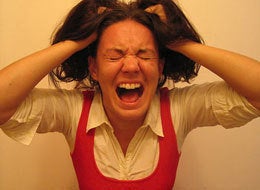
Self-injury is making headlines. According to the latest statistics, from 15% to 22% of all adolescents and young adults have intentionally injured themselves at least once in their lifetimes. That number spiked to 54% in one study of girls between ages 10 and 14. LA Times health reporter Shari Roan writes, "Cutting, burning and biting one's body is a habit increasingly taken up by young people who find themselves simply unable to cope with stress. Embedding appears to represent a more extreme form of the disorder."
Embedding -- as in stapling one's own flesh, or sliding needles or open paper clips under the skin, to create a constant source of pain. I'm reminded of a young woman I met a couple of years ago who had piercings in her chin, cheeks, eyelids -- all of which were red and oozing and looked self-inflicted. She was a new student, entering a graduate program in which many of her fellow students were writing about trauma. She would be in good company, if her plan was to write about the reasons why she hurt herself, but it was so painful just to look at her that most of us couldn't, and she soon dropped out of the program.
I am sorry I couldn't look at that poor suffering soul, couldn't get past the overt evidence of her anguish. Writing out her emotions most likely would have done her great good. But when I did look at her I couldn't help wincing at the pain that her self-injury, paradoxically, was helping her mute. How to explain that paradox? Chemistry.
Frustratingly few media accounts of self-injury ever address the fundamental reason why people hurt themselves when they're distressed. Surely, they must be mentally ill? Not necessarily. While one relatively small group of self-injurers are hard-core and suicidal, and another small group harm themselves as a cry for attention and help, it seems that 80% occasionally cut or tear their skin when they are under stress - arguably, this group includes lifelong nail biters, like me -- but have no other symptoms of mental illness. Roan notes that, "Most therapists agree that self-injury helps relieve negative emotions, at least temporarily."
Okay. Fine. But how does it provide relief? General science writers rarely go there, though researchers have been uncovering the answer for the past three years. That answer is elegantly simple, really. Self-injury produces a quick chemical time-out.
The body has a miraculous mechanism to protect us against an overload of physical pain. Break the skin, and opiates flood the brain. These natural pain killers involve neurotransmitters like dopamine and serotonin, and the endogenous opioid peptides.
In a study published in 2005, UC Irvine researchers Curt A. Sandman and William P. Hetrick explained that the "natural high" provoked by self-harm can be as addictive as pills. "Both painful shock and restraint stimulate release of the body's own opiates into the bloodstream. These powerful agents, which possess analgesic and addictive properties, are more potent than morphine... As a consequence, individuals exhibiting SIB [self-injurious behavior] become addicted to their own opiate system."
Understanding the chemical basis of this behavior helps to de-mystify it. People do not cut themselves because they get a thrill out of seeing their own blood or shocking their friends; they do not tear their hair out because they are monsters; they do not stick needles in their flesh because they are insane. They do these things for the resulting chemical sensation of relief, calm, and safety. The sensation that nothing can hurt you is the body's way of announcing that you've already been hurt too much.
I remember my own profound experience with this sensation some thirty years ago after accidentally puncturing my palm in a fall onto broken glass. Before I went into shock, I stared down at my gaping flesh and marveled at the inner depths of my hand. I remember feeling no pain but distinctly thinking, "How amazing. It seems to go on forever in there. Who knew?" Meanwhile, everyone around me was racing to get me to the hospital for the six hours of surgery I would require to stitch my severed nerves, ligaments, muscle, and flesh back together.
Clearly, opiates serve a purpose. They mute the pain and help us survive.
It makes sense, then, that some individuals will turn to those same opiates after they have been hurt emotionally. Rates of sexual, physical, and emotional trauma run high among those who self-injure, just as they do among those who abuse alcohol and drugs, and among those who struggle with eating and exercise disorders. Intense, out-of-control stress is the common denominator.
Many who self-harm also engage in those other behaviors. That's because these actions all produce some chemical sensation of relief, be it an endorphin high, a serotonin plunge, a dopamine spike, or a narcotic haze. You don't necessarily have to abuse alcohol or illegal substances to experience chemical addiction.
I've been writing for several years about the need for a more integrated approach to research and treatment for eating disorders. Doctors, families, and the general public need to understand that syndromes like anorexia, bulimia, and binge eating are not caused by either culture or genes, chemistry or emotions, behavior or biology. Rather, they are caused by all of the above. The same is true of self-harm behaviors. As Frank Symons, a researcher now studying self-injury and biologically-based pain research, said in a recent interview, "Because you can show that social consequences can affect a behavior problem does not mean biology is irrelevant and vice versa."
It's easy to sensationalize problems like self-injury and anorexia as grotesque aberrations, but the truth is, these are natural reactions for a body in acute distress. Instead of wincing at the symptoms, we would all do better to consider -- and resolve -- the many less visible sources of pain that are prompting our young to turn themselves into human pin cushions.